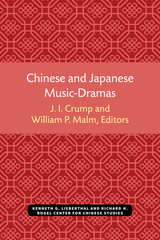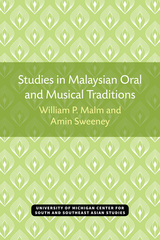2 books by Malm, William

Chinese and Japanese Music-Dramas
J. I. Crump and William P. Malm, Editors
University of Michigan Press, 1975
Chinese and Japanese Music-Dramas is the result of a conference on the relations between Chinese and Japanese music-drama held at the University of Michigan, Ann Arbor, on October 1–4, 1971. In addition to the Association for Asian Studies, four U-M departments participated in the conference: the Center for Japanese Studies, the Center for Chinese Studies, the School of Music, and the Speech Department. One important inspiration for the creation of such an interdisciplinary conference was the fact that each participant had found, after years of individual research on music-drama in East Asia, consistent frustration caused by attempts to deal on their own with multiple cultural and technical problems. Another motivating force was an awareness among many members of the four disciplines involved that the topic is in fact one of the largest untouched fields of scholarly endeavor in both Asian and theatrical studies.
The collection opens with J. I. Crump’s exploration of the Ming commentators who began to subject Yüan musical drama to the same critiques as other literature from the past. In the second chapter, Rulan Chao Pian looks to the structure of arias in Peking Opera for clues about what distinguishes this art form. William P. Malm turns to three key sources for the performance conventions of Japanese Noh drama to glean any Sino-Japanese music relationships that exist in technical terms and practices. In the fourth essay, Carl Sesar analyzes a Noh play that stages the tension between Chinese influence and Japanese originality. Roy E Teele concludes the volume with a formal study of Noh play structure to assess lineages of influence from Chinese dramatic forms. After each contribution, the editors print a transcript of the conference participants’ discussion of that paper, providing the reader with a detailed and nuanced view of how the contributors understood and responded to each other’s work.
[more]

Studies in Malaysian Oral and Musical Traditions
William P. Malm and Amin Sweeney
University of Michigan Press, 1974
The first of two studies included is “Music in Kelantan, Malaysia and Some of Its Cultural Implications,” by William P. Malm. Kelantan is the northernmost province on the east coast of Malaysia. It is considered to be the most orthodox area in a nation whose state religion is Islam. At the same time it must be noted that it borders to the north with the Buddhist country of Thailand and to the west is the Malaysian province of Perak whose jungles and mountains contain many “pagan” tribal traditions. Beyond Perak is Kedah with its larger Indian and Chinese populations and to the south is Trengganu where some Indonesian traits are still to be found. It is in this context that Malm’s study of music is made.
The second study is “Professional Malay Story-Telling: Some Questions of Style and Presentation” by Amin Sweeney. In view of the hitherto almost exclusive concern with the content of such tales as those of Sang Kanchil or Pak Pandir, Sweeney throws some light on the form, style, and presentation of oral Malay literature, with special reference to that class of story-telling popularly known as penglipur lara, or what Winstedt termed “folk romances.”
[more]
READERS
Browse our collection.
PUBLISHERS
See BiblioVault's publisher services.
STUDENT SERVICES
Files for college accessibility offices.
UChicago Accessibility Resources
home | accessibility | search | about | contact us
BiblioVault ® 2001 - 2024
The University of Chicago Press









